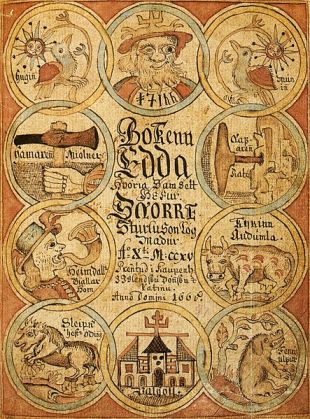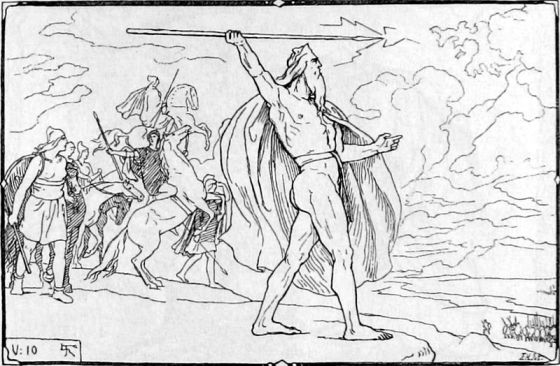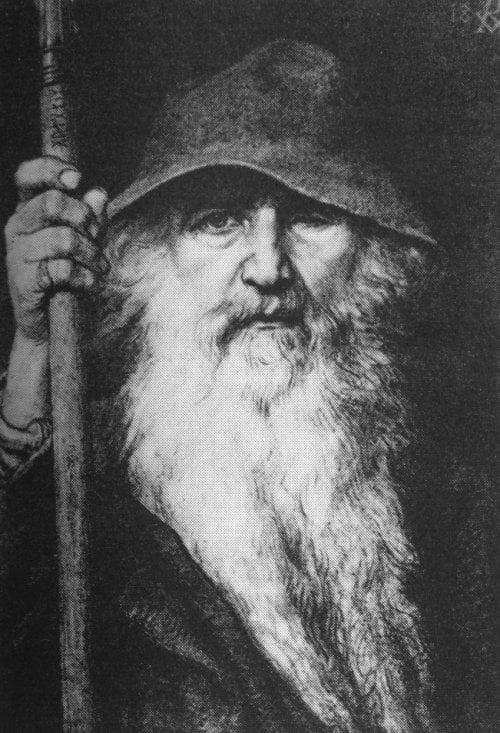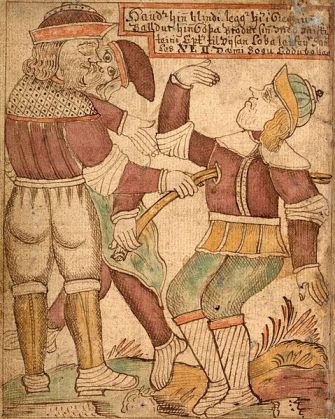Every culture has their hero stories but few resonate so profoundly across the ages as those of the Vikings. Tales of the gods like Thor, Freya, and Odin are more famous now than they were even during the time of the Norse raids.
The stories we know today are from a body of literature drawn from a time of great change for the Vikings. As Christianity proselytized its way across Europe, oral traditions were often recorded for the first time by devout churchmen.
These scholars were fascinated with the pagan sagas and hastened to set down final versions for all time. However, it was impossible for them not to alter the stories for their intended audience.
The versions of the great tales we possess today are a snapshot of Europe during a period of Christianization. They cannot fully represent the culture of the pagan, seafaring Vikings. We can only hope that some Churchmen stayed more faithful to the originals than others.
Primary Sources of the Tales
The Prose Edda
The Prose Edda is also known as the Younger Edda and is from the 13th century. Believed to have been compiled and in part written by the Christian Icelandic scholar and historian Snorri Sturluson.

It is divided into four parts and is considered to be one of the most important sources of knowledge about Norse mythology today. It tells about the gods and their stories but also served as a manual for producing skaldic, or traditional, Norse poetry.
The Poetic Edda
The Poetic Edda is a 13th-century compilation of skaldic poetry with origins that are not completely known. Several versions of the Poetic Edda exist, but they are all mostly based upon the 31 poems found in the Codex Regius.
The Codex Regius
Almost like an adventure story, the Codex Regius was written in the late 13th century but was lost for almost four hundred years before it surfaced in 1643.
The 31 poems along with the Prose Edda are the main sources of everything we know today about Norse mythology.
Importance of the tales of the gods
This collection of stories focuses mainly on the adventures of the Aesir and Vanir gods. Even today these profound myths resonate deeply with people far beyond the borders of the Scandinavian world.
We remain today as fascinated as ever with our cosmic origins and our possible extinction. It seems that the Vikings were no different. It may be that we have much to learn by studying the wisdom of our collective ancestors.
Reading this today we should bear in mind that these stories were not only entertainment for the Vikings. They formed the very center of their spiritual lives and were the basis for both public and private worship.
As the Vikings had a fluid way of storytelling they didn’t attach any great importance to chronology. Some key events seemingly take place side by side or even change place depending on the story.
The Aesir-Vanir War
In the Norse world, the gods are divided into two main tribes. At the beginning of time, these vastly powerful beings came to blows. Cunning, wisdom, and warcraft on each side were severely tested.
This story tells of their conflict, including hostage exchanges, murders, misplaced worship, and the eventual resolution of their differences.

In true Norse fashion, not every central character survives to tell the tale. Not every set of shoulders is left with a head intact. There is wisdom here not only for us but perhaps for our present world leaders as well.
The Mead of Poetry
Love of mead ran deep in the hearts of Vikings and was a central feature of their culture. Like the nectar of the Greek gods, mead was the divine inspiration of the Aesir and Vanir tribes.
Odin undergoes a series of adventures to obtain the precious liquid that confers gifts of poetry on those who drink it. The Allfather risks his life to ensure his people would not want for beautiful words and timeless wisdom.
This story recounts Odin’s deeds as he stops at nothing to improve the lives of his people.
The Treasures of the Gods
Thor’s unbreakable hammer Mjölnir is today almost a household name. Although it is the most famous of the treasures of the gods, it is only one among many. Few know the origins of this deeply mythic object.
This tale recounts how Loki stirs up trouble among the dwarves of Svartalfheim. He then inadvertently becomes the bearer of magical gifts. Not only Thor’s hammer but also Sif’s golden hair, Freyr’s magical ship and Odin’s ring and spear.
The Fortification of Asgard
The word ‘gard’ in Asgard indicates that the home of the Aesir is a fortified place. Its walls offer protection from fearsome enemies, such as the frost giants of Niflheim. Vannaheim, by contrast, has no surrounding walls or defenses.
This story relates how a giant convinced the gods to contract him to build a wall around Asgard.
The price for his labor was so high that Loki conspired to fool him into working for no reward. This trickery leads the gods into the kind of trouble that only Loki is capable of creating.
How Odin Lost His Eye
Odin may at times seem violent and even cruel. This tale reveals, another side to Asgard’s King of the Gods. The Allfather is known for his one-eyed visage. This is the story of how such a powerful warrior god came to lose an eye. At the same time, it shows the other side of Odin’s character.

The King of the Gods is a deep lover of wisdom and sacrifices much in search of it. We learn here how far, on this occasion, he was willing to go.
Odin Discovers the Runes
The alphabet of the Vikings survives today not only in university departments but also as a living tradition. Modern pagans still use it as a means to gain knowledge both of the future and oneself.
In Norse tradition, it is Odin we must thank for this magical tool of self-discovery and divination. This tale recounts what deeds Odin undertook to gain this wisdom and some of his most renowned powers.
The Kidnapping of Iduna
Iduna occupies a crucial place in the lives of the gods. She cultivates and distributes the ‘epli’ or divine fruit which gives them their immortality. As such, her protection is of the utmost importance to all who live in Asgard.
Loki consents to her kidnapping to extricate himself from the threats of a giant possessed of magical skills. The tale recounts the series of events leading to her abduction and what follows thereafter.
The Marriage of Njord and Skadi
Gods and giants are natural enemies, stemming from the time when Odin and his brothers slew Ymir the primordial frost giant. They then used his dismembered body to create the 9 realms.
After he was torn apart, the Allfather and his brothers did their best to destroy all the giants in existence. Despite this, the attraction between gods and giants often overcomes their natural antipathy. This tale informs us of the ill-fated marriage between the Vanir god Njord and the giantess Skadi.
The Binding of Fenrir
One of the most compelling of all the Viking tales. This story explains to us how the gigantic wolf Fenrir, a child of Loki, brought fear into the hearts of the gods. They were so frightened that they sought to bind him.

Although the gods were successful, their plan came with certain costs and personal sacrifice among the Aesir. The events in this story have far-reaching implications for the final reckoning of the gods at the time of Ragnarok.
Thor’s Journey to Utgard
There is no god of the Norse pantheon more famous than Thor, God of Thunder. This story follows him on a journey into the hostile world of the giants where lesser gods would fear to tread.
During his time there the Thunder God engages in a series of contests that demonstrate his power and courage. His feats leave the giants in awe of their Aesir enemy.
Thor’s Fishing Trip
If Thor’s visit to Utgard gave the giants respect for his power, his fishing trip leaves the whole world aghast at his great strength.
The Vikings were a seafaring people and were accustomed to finding sustenance from the waves on which they traveled. Thor also enjoyed the pleasures of casting a line into the sea. On this occasion, however, he baits a creature that only he could have snared. His catch is none other than the Midgard Serpent itself.
Thor’s Wedding Day (Thrymskvida)
The Thunder God takes many consorts during the golden age of his long life. Although he leads a charmed, magical existence, even he can be subject to ill luck.
On his wedding day, Thor experiences the ultimate misfortune, losing his greatest weapon to none other than the giants.
In this tale, we learn to what lengths the mighty Thor will go to be reunited with his beloved war hammer.
Thor’s Duel with Hrungnir
Thor saves the day once more in this story that Odin begins but which his son ends. Hrugnir is a member of the giant folk but is no ordinary denizen of Jotunheim. The most powerful of all giants succeeds in entering Asgard and terrifying the gods.
At their wit’s end, they finally call upon their greatest hero to dispatch the overbearing, and seemingly unbeatable giant. Thor is more than happy to take on the task and the battle becomes one of his greatest ever.
The Death of Baldur
This tale brings sorrow, like no other, to the hearts of all who love the Norse gods. Baldur, brother of Thor, son of Odin, is lost to Asgard through the vile trickery of none other than Loki.

Baldur is no ordinary god. During his lifetime he was beloved as the kindest, and wisest of the Aesir. Thor’s great brother embodied light, mildness, calm, and wisdom. If Loki is the most hated of all the gods, it must surely be for his role in the death of Baldur.
The Punishment of Loki
The Death of Baldur may be the hardest of all the Norse tales to read. The Punishment of Loki, however, might be the most satisfying.
Loki is found, time and again, to be the cause of mischief and pain to the gods. Yet, time and again the gods forgive and allow him to continue dwelling among them. His role in the death of Baldur, however, is a step too far. The punishment meted out to him for this act is terrible indeed.
